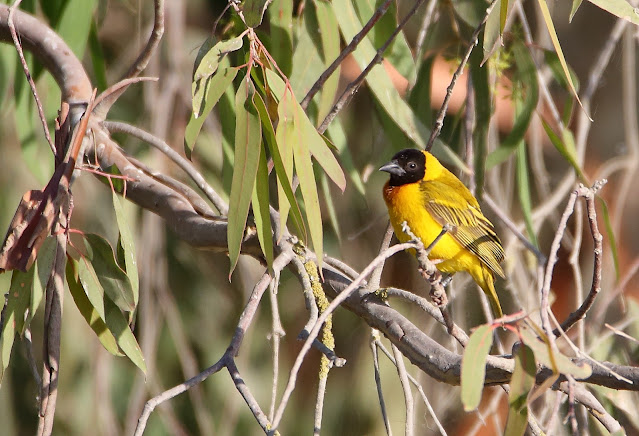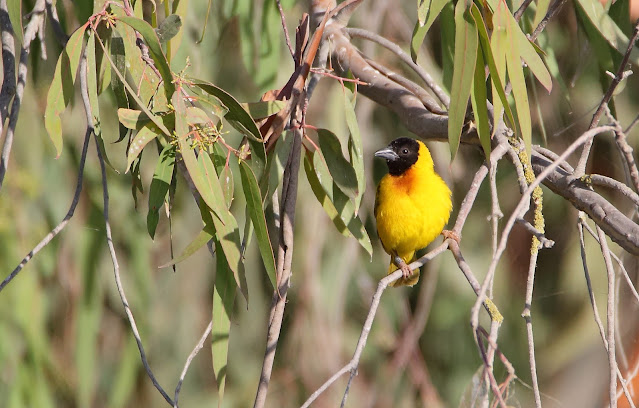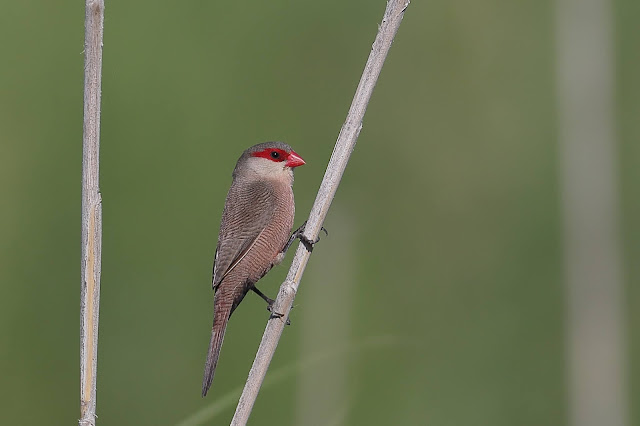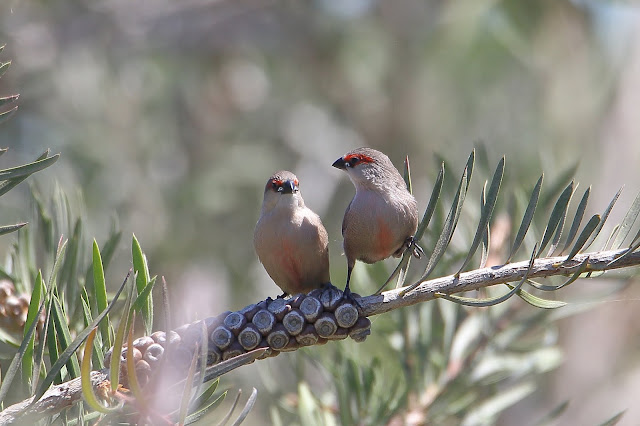Hola una vez más.
Hi again.
Hi again.
En el siguiente enlace podéis ver nuestros próximos viajes fotográficos y de observación de aves y mamíferos nacionales y al extranjero. Espero que os gusten y os animéis a venir conmigo. Una experiencia que nunca olvidareis.
In the following link you can see our next national and foreign Birds and Mammals photographic and observation trips. I hope you like them and I encourage you to come with me. An experience that you will not forget.
En esta ocasión os voy a enseñar
cuatro especies de aves exóticas que se pueden ver en territorio español y que
no son autóctonas. Se las considera aves alóctonas.
On this occasion I am going to show you four species of exotic Birds that can be seen in Spanish territory and that that are not native. They are considered allochthonous Birds.
On this occasion I am going to show you four species of exotic Birds that can be seen in Spanish territory and that that are not native. They are considered allochthonous Birds.
En la Lista de Aves de España - SEO Birdlife 2019 estas cuatro especies pertenecen a la categoría C.
Categoría C: Especies exóticas que, habiendo sido introducidas deliberada o accidentalmente por el hombre, han establecido poblaciones reproductoras regulares que se mantienen de forma autosuficiente, independiente y estable, o bien incrementan su demografía manifestando características invasoras. (Fuente, SEO/Birdlife).
In the Lista de Aves de España - SEO Birdlife 2019 these four species belong to category C.
Category C: Alien species that, having been deliberately or accidentally introduced by man, have established regular reproductive populations that remain self-sufficient, independent and stable, or else increase their demography by showing invasive characteristics. (Source, SEO / Birdlife).
La primera de ellas que he
seleccionado es el bengalí rojo (Amandava amandava).
Macho en periodo reproductor.
Male in breeding plumage.
Son francamente bonitos.
They are very beautiful.
Es un ave de origen asiático,
Pakistán, India e Indonesia. Son aves muy pequeñas de tan solo 9 cm. de longitud
y una envergadura de 14 cm.
It is a bird of Asian, Pakistan, Indian and Indonesian origin. They are very small birds of only 9 cm. in length and a wingspan of 14 cm.
Los machos en periodo reproductor
son muy llamativos y por ello, en el siglo pasado, abundaban como aves de
jaula. Además, son muy adaptables lo que motivo que las aves escapadas se
estableciesen en bastantes países fuera de su área de distribución como por
ejemplo España, Portugal, Francia, Egipto, Israel, Japón, Puerto Rico, etc.
Males in the reproductive period are very striking and therefore, in the last century, they were abundant as cage Birds. In addition, they are very adaptable, which is why escaped Birds settled in many countries outside their range, such as Spain, Portugal, France, Egypt, Israel, Japan, Puerto Rico, etc.
Males in the reproductive period are very striking and therefore, in the last century, they were abundant as cage Birds. In addition, they are very adaptable, which is why escaped Birds settled in many countries outside their range, such as Spain, Portugal, France, Egypt, Israel, Japan, Puerto Rico, etc.
En la España peninsular, se la ha
podido observar hasta en 14 provincias siendo más numerosos en Extremadura, Vegas
del Guadiana, Alagón y Tiétar, Madrid, Granada, Málaga y Sevilla. No estando
presente ni en Baleares ni en Canarias.
In mainland Spain, it has been observed in up to 14 provinces, more numerous in Extremadura, Vegas del Guadiana, Alagón and Tiétar, Madrid, Granada, Malaga and Seville. Not being present neither in the Balearic Islands nor in the Canary Islands.
In mainland Spain, it has been observed in up to 14 provinces, more numerous in Extremadura, Vegas del Guadiana, Alagón and Tiétar, Madrid, Granada, Malaga and Seville. Not being present neither in the Balearic Islands nor in the Canary Islands.
Habita exclusivamente zonas de
regadío con plantaciones de maíz, arroz, o caña de azúcar. En la foto un macho que no ha adquirido aún el plumaje nupcial en su totalidad.
It inhabits exclusively irrigated areas with corn, rice, or sugar cane plantations. In the photo a male that has not yet acquired his fully breeding plumage.
Otros machos con parte de la muda a plumaje nupcial.
Other males with part of the moult to breeding plumage.
Es un ave granívora de acusado
dimorfismo sexual en época de reproducción. Además, se reproducen en los meses
de julio a octubre que coincide con la época de los Monzones en sus lugares de
origen. Fuera de esta época los machos y las hembras son similares. En la foto una hembra.
It is a granivorous bird with marked sexual dimorphism during the breeding season. In addition, they reproduce in the months of July to October, which coincides with the monsoon season in their places of origin. Outside this time males and females are similar. In the photo a female.
It is a granivorous bird with marked sexual dimorphism during the breeding season. In addition, they reproduce in the months of July to October, which coincides with the monsoon season in their places of origin. Outside this time males and females are similar. In the photo a female.
La segunda especie que os voy a
mostrar es el tejedor cabecinegro (Ploceus melanocephalus). En la foto un macho en plumaje nupcial.
The second species that I am going to show you is the Bblack-headed Weaver. In the photo a male in breeding plumage.
Es un ave de origen africano que habita principalmente en África central y occidental de tan solo 12 cm de longitud. Al igual que en la especie precedente, los macho en plumaje nupcial son muy llamativos y además construyen unos intrincados nidos que tejen con vegetación y sitúan en las ramas de los árboles encima del agua y en colonias para evitar, en la medida de los posible, la depredación de estos.
It is a Bird of African origin that lives mainly in central and western Africa, measuring only 12 cm in length. As in the previous species, males in breeding plumage are very striking and also build intricate nests that they weave with vegetation and place in the branches of trees above water and in colonies to avoid, as far as possible their predation.
Esta especie se la puede encontrar también en otros países fuera de su rango geográfico nativo como Portugal y República Dominicana.
This species can also be found in other countries outside its native geographic range such as Portugal and the Dominican Republic.
Normalmente son los machos los que se encargan de la construcción de los nidos.
Usually it is the males who are in charge of the construction of nests.
Es un ave granívora que está asociada a los cauces de los ríos y que en España se la puede observar en Sevilla, Cádiz y Málaga.
It is a granivorous Bird that is associated with river beds and in Spain it can be seen in Seville, Cádiz and Malaga.
Un macho que aún no ha adquirido su plumaje nupcial al completo.
A male that has not yet acquired its full breeding plumage.
Otro más.
Another one.
Un nido acabado.
A finished nest.
Las hembras, y los machos fuera del periodo reproductor, son muy similares.
Females, and males outside the reproductive period, are very similar.
Una hembra a la entrada de su nido.
A female at the entrance to her nest.
El siguiente en la lista es la estrilda común (Estrilda astrild).
Next on the list is the Common Waxbill.
Esta pequeña ave de tan solo 11 cm de longitud y 13 cm. de envergadura es oriundo del África subsahariana.
This little Bird is only 11 cm in length and 13 cm. wingspan. It is from Sub-Saharan Africa.
Por su belleza se hizo muy popular como ave de jaula y debido a su gran adaptabilidad se ha pasado a formar poblaciones estables en muchos países fuera de su rango como España, Portugal, Brasil y numerosas Islas del mundo.
Due to its beauty it became very popular as a cage Bird and due to its great adaptability it has become stable populations in many countries outside its range such as Spain, Portugal, Brazil and many islands of the world.
En España la podemos encontrar en mayor abundancia en las vegas extremeñas del Guadiana y en el suroeste de Galicia. También hay núcleos menos numerosos en Gran Canaria, Sevilla, Cáceres, Barcelona, Valencia, Málaga, Mallorca y Tenerife.
In Spain we can find it in good numbers in the Extremadura valleys of Guadiana and in the southwest of Galicia. There are also less numerous nuclei in Gran Canaria, Seville, Cáceres, Barcelona, Valencia, Malaga, Mallorca and Tenerife.
Es un ave granívora que en principio se asentó en zonas con vegetación palustre pero debido a su gran adaptabilidad ha ido expandiéndose por otras áreas con abundancia en plantas herbáceas como campiñas, regadíos, cultivos de frutales, etc. No tienen un dimorfismo sexual acusado, siendo machos y hembras muy similares y se pueden reproducir a lo largo de casi todo el año.
It is a granivorous Bird that initially settled in areas with marshy vegetation but due to its great adaptability it has been expanding into other areas with abundance in herbaceous plants such as countryside, irrigated land, fruit crops, etc. They do not have a marked sexual dimorphism, being very similar males and females and can reproduce throughout most of the year.
Los jóvenes tienen el pico negro en lugar de anaranjado y conservan sus llamativas boqueras durante bastante tiempo. Su color es más apagado que el de los adultos.
Juveniles have black beaks instead of orange and retain their conspicuous mouths for a long time. Its color is duller than that of adults.
La última especie que os muestro hoy es el obispo coronigualdo (Euplectes afer). En la foto un macho en plumaje nupcial haciendo el cortejo.
The last species that I show you today is the Yellow-crowned Bishop. In the photo a male in breeding plumage in courtship display.
Esta especie es oriunda del África subsahariana que, como en el caso de las otras especies tratadas en este blog, debido a su belleza, mantenimiento como ave de jaula y adaptabilidad ha invadido otros países como España, Portugal, Jamaica, Japón y Venezuela.
This species is native to Sub-Saharan Africa which, as in the case of the other species discussed in this post, due to its beauty, maintenance as a cage Bird and adaptability has invaded other countries such as Spain, Portugal, Jamaica, Japan and Venezuela.
Son aves pequeñas de unos 10 cm. de longitud con una pequeña cola y granívoras que están ligadas generalmente a zonas de regadío o palustres en donde hay bastantes plantas herbáceas. Se alimentan de sus semillas.
They are small Birds of about 10 cm. long with a small tail and granivores that are generally linked to irrigated or reed areas where there are many herbaceous plants. They feed on its seeds.
Un macho con material para su nido.
A male with material for his nest.
Son muy bonitos.
They are very pretty.
Presenta un acusado dimorfismo sexual en época de reproducción en la que los machos son amarillos y negros. Fuera de esta época los sexos son muy similares.
It presents a marked sexual dimorphism in breeding season in which males are yellow and black. Outside of this time sexes are alike.
Y para finalizar os dejo con estas imágenes de hembra/ macho en periodo no reproductor.
And finally I leave you with these images of female / male in non-breeding period.
Si queréis suscribiros a este blog de los viajes que hacemos pincha en el siguiente enlace: Suscribirse y haz clic en ¿Quieres suscribirte a nuestro blog?
If you want to subscribe to this post about the trips we do, click on the following link: Susbcribe and click on: Do you want to subscribe to our blog?
If you want to subscribe to this post about the trips we do, click on the following link: Susbcribe and click on: Do you want to subscribe to our blog?
Espero que os haya gustado y hasta pronto.
I hope you like it and see you soon.































































Un reportaje precioso Luis.
ResponderEliminarRecuerdo que en el reciente viaje a Portugal nos mostraste abundantes grupos de Estrilda y Obispo Cabecigualdo.
Como todos tus viajes una maravillosa aventura para los sentidos.
Muchas gracias Antón.
EliminarDa gusto tener amigos como tu.
Abrazos,
Luis
Muy bonitas, aunque sean invasoras. Y buenas fotos. Gracias Luis. Un cordial saludo y felices fiestas.
ResponderEliminarMuchas gracias Alejandro.
EliminarTambién te deseo felices fiestas.
Saludos,
Luis
Yo te felicito por este blog. Me ha parecido interesantísimo, yo lo desconocía por completo. Muy didáctico y muy bien explicado. Una suerte haberte conocido, y disfrutar de los pájaros contigo. De las fotos ya ni hablamos. Un saludo.
ResponderEliminarMuchas gracias Gonzalo, me alegra que te haya gustado.
EliminarUn saludo,
Luis